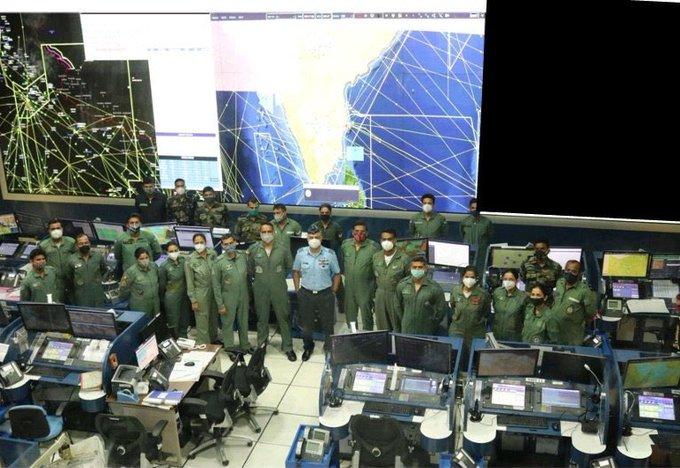
- The job of JADC was to ensure the seamless integration of Akashteer, in land, air and sea, making a robust C4ISR framework.
- During Operation Sindoor, Akashteer’s vehicle-mounted nodes, linked via AFNet, and inputs from TRIGUN enabled Akashteer to counter sea-launched drones, complementing land and air defences.
- Akashteer’s AI-driven automation, supported by IACCS and AFNet, dynamically allocated resources, neutralising 600 Pakistani projectiles.
- Akashteer redefines air defence with its integrated, AI-driven architecture, surpassing the Iron Dome’s short-range focus, the S-400’s centralised limitations, and the HQ-9’s lack of interoperability.
In the rapidly evolving landscape of aerial warfare, where drones, hypersonic missiles, and saturation attacks pose unprecedented challenges, India’s Akashteer emerges as a pinnacle of indigenous innovation. Developed by Bharat Electronics Limited (BEL) in collaboration with the Defence Research and Development Organisation (DRDO) and the Indian Space Research Organisation (ISRO), Akashteer integrates seamlessly with the Tri-Services of the Indian Armed Forces. JADC integrates IAF’s IACCS, alongside the Indian Navy’s TRIGUN platform and the Indian Army’s ground-based AD systems. Its stellar performance during Operation Sindoor (May 7-10, 2025), neutralising over 600 Pakistani drones, rockets, and missiles, has earned accolades from experts like Tom Cooper and John Spencer. Unlike Israel’s Iron Dome, Russia’s S-400 Triumf, or China’s HQ-9, Akashteer’s tri-service synergy, advanced radar integration, and gap-free architecture set it apart.
Tri-Service Synergy: Joint Air Defence Centre (JADC)
It was the dream of Gen Bipin Rawat to integrate India’s stellar tri-forces defence systems into one, the Joint Air Defence Centre (JADC), as proposed by Gen Vinod Anand. The job of JADC was to ensure the seamless integration of Akashteer, in land, air and sea, making a robust C4ISR (Command, Control, Communications, Computers, Intelligence, Surveillance and Reconnaissance) framework. The strength lies in the integration of the Indian Army’s ground-based air defence in the Tactical Battle Area (TBA), with the Indian Air Force’s IACCS, bolstered by the secured Air Force Network (AFNet) and the Navy’s TRIGUN platform, forming a robust tri-service defence network. IACCS, a BEL-developed command-and-control system, fuses data from ground-based radars, airborne sensors, civilian radars, and ISRO’s GSAT-7A satellite to generate a real-time Recognised Air Situation Picture (RASP).
AFNet, launched in 2010, connects over 150 IAF stations with 1 Gbps bandwidth and encryption. Under a 2015 MoU between the Department of Telecom and Ministry of Defense, AFNet was enhanced with 40,000 route kilometers of optical fiber cable, linking 219 Army stations, 33 Navy stations, and 162 Air Force points, alongside an exclusive defense band and interest zones within 100 km of India’s borders, encrypted and reserved solely for the Armed Forces application. TRIGUN, the Navy’s maritime domain awareness platform, integrates sea-based radars, sonars, and communication nodes, enabling real-time threat detection across coastal and deep-sea regions. It leverages the GSAT-7 satellite for secure naval communications, enhancing Akashteer’s maritime coverage. TRIGUN integrates naval sensors, enhancing maritime threat detection.
During Operation Sindoor, Akashteer’s vehicle-mounted nodes, linked via AFNet, and inputs from TRIGUN enabled Akashteer to counter sea-launched drones, complementing land and air defences and coordinating Army Air Defence (AAD), IAF jets, and naval assets, neutralising Pakistan’s multi-vector attack. As Chief of Urban Warfare Studies, John Spencer remarks, “India demonstrated both the strength of its layered air defences—many indigenously built, alongside Israeli and Russian systems—and its ability to penetrate Pakistan’s Chinese-made defences like the HQ-9/P, LY-80, and FM-90.”
Akashteer integrates seamlessly with the Tri-Services of the Indian Armed Forces.

Global Counterparts: Iron Dome, S-400, and HQ-9
Akashteer outshines global systems. Israel’s Iron Dome excels at short-range rocket interception (4–70 km) but falters against high-altitude or saturation attacks, as seen in 2023 Hamas barrages and 2024 Hezbollah strikes, with over 5,000 rockets launched, achieving only an 85% interception rate due to limited missile reload capacity. Russia’s S-400, despite its 400 km range, was compromised in Crimea (2023), where Ukraine’s HARM missiles exploited radar downtime, destroying two launchers. China’s HQ-9, used by Pakistan, has a 200 km range but lacks interoperability, failed miserably in Operation Sindoor, proving that Akashteer’s tri-service design outclasses HQ-9’s rigidity.
Advanced Radar Integration: Rohini, Arudhra, Ashwini, MF-STAR and 91N6E
Akashteer’s radar suite, including the indigenous Rohini and Israeli co-developed MF-STAR, is pivotal to its effectiveness. The Rohini 3D Tactical Control Radar, co-developed by DRDO and BEL, offers a 150 km range, detecting low-altitude targets like drones with high precision. Its S-band operation ensures all-weather performance, critical for India’s diverse terrain. The MF-STAR, a Ga-N based multi-function phased-array Naval radar jointly developed by India and Israel, provides 250 km detection and 360-degree coverage, excelling against stealth threats and missiles. The S-400’s 91N6E Big Bird radar, with a 600 km detection range, tracks ballistic missiles and aircraft, while the 96L6E Cheese Board radar enhances low-altitude detection up to 300 km, complementing Rohini’s capabilities.
The Arudhra, a 4D multi-function phased array radar by BEL, provides electronic steering in azimuth and elevation, enabling precise surveillance, detection, and tracking of aerial targets up to 300 km. The Ashwini Low-Level Transportable Radar (LLTR), a DRDO-developed 4D rotating active phased array, has a 200 km instrumented range, detecting 2 sqm RCS targets at 150 km with altitude coverage from 30 meters to 15 km.
While threat interception was carried on by these systems individually, detection of threats was done as one big Radar covering the entire LOC. During Operation Sindoor, Rohini and Ashwini tracked low-flying Pakistani drones, MF-STAR and Arudhra guided Barak-8 interceptors against PL-15 missiles, and S-400 radars detected ballistic threats. Integrated with IACCS’s RASP, these radars feed real-time data to Akashteer’s AI, ensuring precise target classification and engagement. A successful radar fusion and integration of indigenous and imported systems creates a layered detection and interception envelope, the modern Bharat’s Sudarshan Chakra.
Eliminating Downtime Gaps: A Layered Defence
Traditional air defence systems, like the S-400 and Iron Dome, face vulnerabilities, gaps created during post-interception “reboot” periods for radar recalibration or reloading. Akashteer’s layered architecture, combining Akash (30 km), Barak-8 (100 km), and S-400 (400 km) systems, ensures continuous coverage. The idea is simple: as and when one system is offline, others take over seamlessly, filling any gaps whatsoever. The gaps can be created either during the Radar downtime, the Reset of AD or the non-overlap of radars. In Operation Sindoor, Akashteer’s AI-driven automation, supported by IACCS and AFNet, dynamically allocated resources, neutralising 600 Pakistani projectiles. Ukraine exploited the S-400 radar gaps, which are placed 75 kilometres apart in Crimea, but Akashteer’s Tri-Services Radar integration makes such vulnerabilities obsolete. The system’s fusion of Indian radars like Rohini, along with Israeli MF-STAR and Russian 96L6E, with indigenous Navigation systems like NavIC ensures no threat slips through Indian skies, however big or small.
Akashteer’s integration with IACCS’s RASP and AFNet minimises friendly fire risks in complex airspaces.
Friendly Fire Prevention: Unified Air Picture via RASP
One cannot forget the fateful day of the aftermath of Balakot strikes, 2023, when a Mi-17 chopper was shot down in a Friendly Fire, leading to the death of six Air Force personnel and a civilian. But Indian Armed Forces accepted this failure with humility, and this led to the Akashteer and Tri-forces integration with flying colours.
Akashteer’s integration with IACCS’s RASP and AFNet minimises friendly fire risks in complex airspaces. By fusing data from radars like Rohini, MF-STAR, etc. and with Airborne Early Warning and Control System (AEW&CS) like Netra-1, Akashteer distinguishes friendly assets like IAF jets or Naval helicopters from hostile targets. Akashteer’s centralised control with decentralised execution prevents fratricide, a major challenge to most defence systems. During Operation Sindoor, Akashteer’s AI, backed by NAVIC’s geolocation, ensured zero friendly fire incidents. Air Marshal AK Bharti emphasised the IAF’s dependence on AFNET, stating that IACCS provided a “net-centric operational capability, which is vital to modern-day warfighting.” This unified air picture, enhanced by TRIGUN’s maritime inputs, sets Akashteer apart.
Real-Time Threat Neutralisation: Operation Sindoor’s Triumph
Operation Sindoor showcased Akashteer’s ability to counter saturation attacks, a challenge that overwhelmed Iron Dome in 2023. Pakistan’s assault, involving drones, PL-15 missiles, and rockets, targeted Indian infrastructure. Akashteer, integrated with IACCS’s RASP and TRIGUN, executed a multi-layered response: S-400s neutralised long-range airborne threats like SAB 2000 and ballistic missiles like Shaheen-1, Akash handled drones, and Barak-8 tackled mid-range targets, guided by MF-STAR and Rohini radars. Electronic warfare jamming disrupted enemy guidance. Akashteer’s sensor-to-shooter loop, enabled by AFNet, is lightning-fast. Its real-time automation marks a shift to proactive warfare. Akashteer not only outperformed overhyped Chinese tech like Pakistan’s HQ-9, which lacked integration, but also ensured zero breaches.
Global Impact: What lies in the future?
Akashteer redefines air defence with its integrated, AI-driven architecture, surpassing the Iron Dome’s short-range focus, the S-400’s centralised limitations, and the HQ-9’s lack of interoperability. With 107 of 455 systems delivered by November 2024, Akashteer’s phased induction targets completion by March 2027, aligning with Project Kusha’s 2028-29 goals. Its AI upgrades counter hypersonic threats, and the Akash-NG (80 km) attracts export interest from countries like Armenia. Integration with IACCS, AFNet, and TRIGUN, supported by GSAT-7A, ensures a robust C4ISR framework, with 65% of equipment domestically produced. Akashteer, based on Dr. Prahlada Ramarao’s research, redefines air defence with its tri-service synergy, advanced radars like Rohini and MF-STAR, and gap-free architecture. Its Operation Sindoor success highlights its edge over other defence systems, given a much larger border (3323 kms) that Akashteer covers. As India advances towards Modern Warfare, Akashteer stands as a testament to indigenous innovation, cementing India as a global air defence benchmark.
Abhinav is an accomplished Engineer, Technical Writer and consultant, who has worked for prestigious Navratna PSUs of India. He is an expert on matters related to Defense and Technology. Views are personal.
